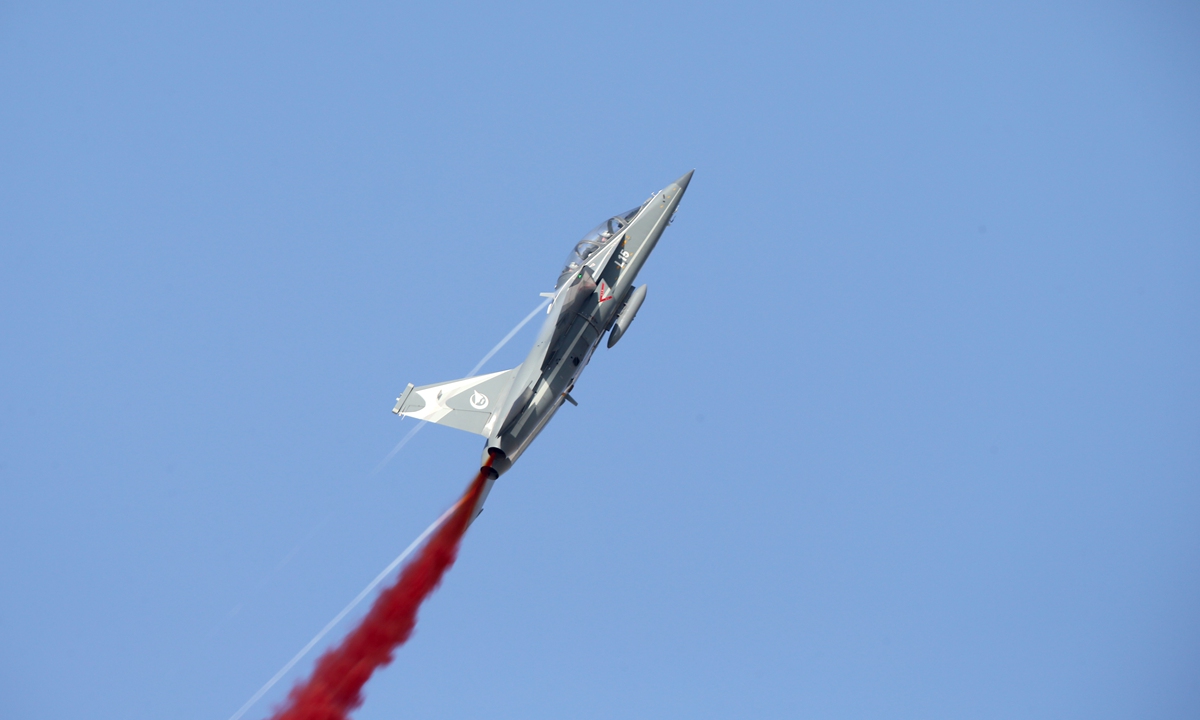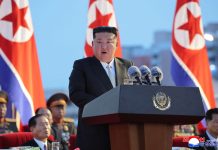China’s L-15 advanced jet trainer made its debut at the Dubai Airshow 2021. The aircraft is capable of undertaking both air defense and ground attack missions.
The L-15 showcased a variety of stunts including vertical and horizontal maneuvers, horizontal rolls, reversed flights, large angle and small speed passes at the airshow.
On November 15, a Twitter user shared a video of China’s two-seater twin-engine supersonic jet trainer Hongdu L-15 showcasing its capabilities, describing it as a cost-effective and highly maneuverable aircraft.

Earlier, a picture of an L-15 taxiing beside a US F-16 fighter jet at the Dubai Airshow was widely circulated in Chinese media, implying tensions between the two countries.
According to the Global Times, despite the pandemic, China chose to showcase the L-15, which is considered the best “advanced trainer” model, in Dubai, demonstrating China’s commitment to the Middle East military market.
A media release quoted by Global Times said the L-15 and the weaponry it can hold were the main subjects of the outdoor static exhibition area.
Chinese two-seater twin-engine supersonic jet trainer Hongdu L-15 demonstrates in-air at #DubaiAirshow2021.
On-par with third-generation fighters, L-15 is cost-effective and easy to maneuver.
Full performance:https://t.co/DeegZJbCz9 pic.twitter.com/rHiPxS2UMW— Eva 郑 عائشة (@evazhengll) November 15, 2021
China’s ‘Star’ Jet Trainer
The Hongdu L-15, labeled as a “star model” by the Chinese media, is a two-seat, twin-engine supersonic platform developed to meet the demand for training pilots. This light-attack aircraft is similar to the Leonardo M346 Master, except the Chinese jet incorporates afterburning engines in one variant.
The L-15 designation only refers to export versions of the jet trainer; while the domestic variant is called JL-10. It is manufactured by Hongdu Aviation Industry Group (HAIG).
The plane is intended to train pilots for the Su-27, Su-30, J-10, and J-11 fighters. In comparison to its competitors, the improved design delivers increased pilot safety while lowering training costs.

The aircraft has two AI-222K-25F afterburner turbofan engines, each having a single afterburner thrust of 4200 kg, a full authority digital engine control module, and a 3000 flight hour service life. Additionally, the L-15 trainer is capable of air combat and ground strikes.
With a payload of 3,000 kg, the L-15 training aircraft has six weapon attachment points and can be externally attached to air-to-air missiles, air-to-surface missiles, precision-guided bombs, and general aviation bombs, as well as rocket launching nests.
Eying Foreign Buyers
So far, Zambia is the only foreign customer of the Chinese L-15 aircraft. The Zambian Air Force has spent $100 million on six L-15Zs, as well as simulators and different guided missiles, for its No. 15 squadron.
There were reports suggesting that Venezuela had also expressed interest to buy L-15s in 2015 to enable its pilots to transition to Su-30MK2 and F-16 aircraft. Caracas, however, has put the agreement on hold due to a lack of funds.

In addition, the Uruguayan Air Force has shown interest in purchasing eight L-15s to replace its A-37B Dragonflies. Pakistan, a strong ally of China, is another potential customer of the L-15.
Wang Yanan, a senior expert on aerospace science and technology, told the Global Times that the Middle-Eastern countries are more demanding in the arms trade, and the trainers they previously purchased were mostly made in the United States, the United Kingdom, or Italy.
Now, the L-15 is on par with the products of these developed countries, and it provides more pricing advantages.
- Contact the author at ashishmichel@gmail.com
- Follow EurAsian Times on Google News




